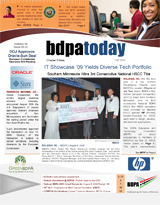|
|
|
bdpatoday
Volume 31 | 10.10.09 |
|
|
|
|
|
bdpatoday blogs, discussions, and
event calendars are enhanced by

2009 Annual Awards Banquet | NOV 12
Reserve tables or tickets today. RSVP on or before October 31.
bdpatoday | online
Missed one? In case we missed you yesterday, our newsletter archives and Acronym of the Day are updated each week for new sponsors, BDPA chapter interest groups (CIGs) and new BDPA members up to the last 100 online editions. Discover more...
5 Key Challenges to DOD's Cybersecurity
Robert Lentz, DOD's retiring chief security officer, identifies achievements and concerns in cybersecurity
bdpatoday--In a recent article, Government Computer News (GCN) reminds readers cybersecurity hinges on authentication. One must have the capability to discern a person or a device's identity for our cyber assets to be protected. In the Defense Department (DOD), the ability to authenticate to the network is not just a good business process, it could actually save lives.
Warfighters can't fight battles without trustworthy information. Warfighters need confidence that they are really talking to credible sources. With the escalating cyber threat looming over our networks, it is imperative that we have strong identity-management capabilities in our policies and in our practices to help warfighters perform their missions more effectively.
Similarly, the business community also needs reliable identity for collaboration especially in our emerging global environment.
To ward against these perpetrators, DOD is strengthening its physical and logical security with the help of the public-key infrastructure Common Access Card for computer access - one of the largest PKI's in the world.
|


PKI
A PKI (public key infrastructure) enables users of a basically unsecure public network such as the Internet to securely and privately exchange data and money through the use of a public and a private cryptographic key pair that is obtained and shared through a trusted authority. The public key infrastructure provides for a digital certificate that can identify an individual or an organization and directory services that can store and, when necessary, revoke the certificates. Although the components of a PKI are generally understood, a number of different vendor approaches and services are emerging. Meanwhile, an Internet standard for PKI is being worked on.
The public key infrastructure assumes the use of public key cryptography, which is the most common method on the Internet for authenticating a message sender or encrypting a message. Traditional cryptography has usually involved the creation and sharing of a secret key for the encryption and decryption of messages. This secret or private key system has the significant flaw that if the key is discovered or intercepted by someone else, messages can easily be decrypted. For this reason, public key cryptography and the public key infrastructure is the preferred approach on the Internet. (The private key system is sometimes known as symmetric cryptography and the public key system as asymmetric cryptography.) A public key infrastructure consists of:
- A certificate authority (CA) that issues and verifies digital certificate. A certificate includes the public key or information about the public key
- A registration authority (RA) that acts as the verifier for the certificate authority before a digital certificate is issued to a requestor
- One or more directories where the certificates (with their public keys) are held
- A certificate management system
______________________
Source:
Tech Target
|
|
|
|
|
|
|
|
|
2009 Annual Scholarship & Awards Banquet
November 12, 6-9 PM
Washington Navy Yard
Conference Center
Keynote: Cynthia Miller
|
NROTC Scholarships
now on deck @ BDPA!
Cover story in bdpatoday
|
FALL 2009 Print Edition
Download versions available 
|
|
|
|
|
|
About BDPA-DC
NBDPA's Washington, D.C. Chapter was founded in 1978 by Norman Mays. It was incorporated in 1981 as a domestic not-for-profit corporation in the District of Columbia. In February of 1988, Black Data Processing Associates of Washington, D.C. Metropolitan Area (BDPA-DC) became an IRS Section 501(c)(3) Public Charity. Today, BDPA-DC provides professional development services for its members and stakeholders in direct support of local and regional STEM (Science. Technology. Engineering. Math) initiatives. Towards this end, BDPA-DC partners with BDPA Baltimore, BDPA Northern Virginia, and BDPA Richmond to support members and stakeholders within the National Capital Region (NCR) and the Baltimore-Richmond Corridor. BDPA-DC also serves NBDPA, BDPA Chapters and Chapter Interest Groups (CIGs) as a federal news bureau, government relations liaison, and bdpatoday newsletter clearinghouse for emerging NBDPA Chapters.
BDPA-DC
611 Pennsylvania Avenue, S.E., Suite 213
Washington, District of Columbia 20003, USA
|
| Select here to join, sign-up a co-worker, or renew memberships | |
|
bdpatoday ISSN 1946-1429 is published by BDPA-DC and participating NBDPA Chapters.
| |
|